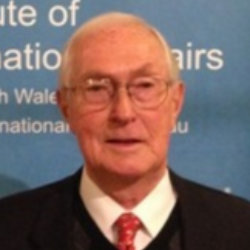GEOFF MILLER. The US-North Korea Negotiations: Death to Forecasters!
May 31, 2018
The pre-negotiation process going on between the US and North Korea is volatile and opaque, but a few points seem to have emerged.
James Bond novels used to feature a sinister Soviet organisation called SMERSH—short for Death to Spies in Russian. The twists and reversals in the process that may lead to a Trump-Kim summit have been so extreme that they could be called Death to Forecasters, or commentators. But a few points can be made.
First, it really is an inside job. No foreign observers are now as well informed about what Kim is thinking and really wants as the three senior figures, President Moon, President Xi and Secretary Pompeo, who have recently each had two talks—in Moons and Xis cases two rounds of talks—with him. So while outsiders can and do speculate we do so in the knowledge that direct talks are going on between the US and North Korea at Panmunjom, in Singapore and, with Kim Yong Chols visit, now in the United States, and that these have as their background very high-level exchanges about which we know very little.
Secondly, from the emphasis placed on this aspect in statements by Trump and Pompeo, it seems that Kim must have given the US reason to believe that he is seriously interested in the economic development of North Korea, and that promises to help in that, or at least to lift the obstacles to others doing so, would be attractive to him. There are grounds for such a US view. Since attaining power Kim has had a two-goal policy of achieving both economic prosperity and nuclear armament. He has had some successes economically, in achieving modest annual GDP growth and a lifestyle for some in Pyongyang that approaches life in other Asian capitals. However the contrast with life in other parts of North Korea is stark, and remedying that in the context of a sanctions regime would seem impossible. So to the extent that Kim wants to achieve his declared national goals that is certainly an inducement to negotiate.
But then we come to the third point, and Kims second goal, the achievement of nuclear weapon status. Its not clear quite how far North Korea has come in regard to this. They certainly have ICBMs capable of reaching the US, and have carried out a series of test nuclear explosions; how well they can—or could—put the two together is not known. But theyve come a very long way, at an enormous cost in scarce resources, and its certainly hard to see them simply giving them up immediately and completely at the demand of the United States, which has been calling for complete denuclearisation. North Korea has indeed put its major nuclear testing site at least temporarily out of commission, but it will certainly want to see an eventual giving up of its nuclear arms balanced, by things like security guarantees, a peace treaty and guarantees against the US seeking regime change. In fact very senior US officials like Secretary Pompeo have said that the US would be prepared to give such guarantees.
But even given such assurances it will be a very big step for North Korea to completely denuclearise, even setting aside the questions of how North Korea might regard the appropriate US and South Korean contributions to the denuclearisation of the peninsula, and the United States reliability as a negotiating partner given Trumps denunciation of the Iran nuclear agreement. Despite its repeated talk of complete denuclearisation the US will have to accept that it wont all be forthcoming at once, and that it will have to give some regard to the North Korean formula of a phased (or gradual) and simultaneous (or reciprocal) denuclearisation.
So what kind of agreement might be reached? One modus vivendi might be found in the concept of front-loading, in which the denuclearisation process would be a gradual and lengthy one (indeed practically it could hardly be otherwise), but the US concern not to simply be played by the North Koreans would be assuaged by a large early step or steps by North Korea. While the North Koreans may well be reluctant to do this, it is probably the unavoidable outcome of Kims goading of the US last year with his threats of his countrys ability to hit the US with nuclear strikes. Those threats certainly got the USs attention (and in a way have already brought North Korea the recognition it has sought), but they have also put pressure on US negotiators to show that they have taken effective steps to neutralise them.
So will the summit happen? Today that looks likely. What will happen at it? Keep an eye on front-loading, security guarantees and economic inducements. And what will be asked of the US as its contribution to reciprocal denuclearisation? Remember, its death to forecasters!
Geoff Miller is a former Australian diplomat, who was Ambassador to South Korea in the late 1970s. He was also Director-General of the Office of National Assessments.
